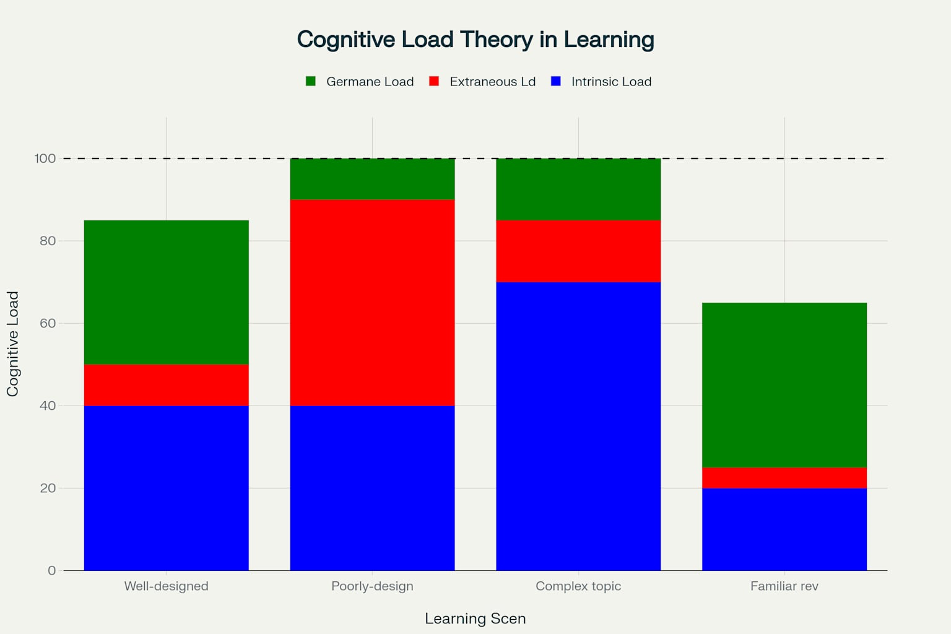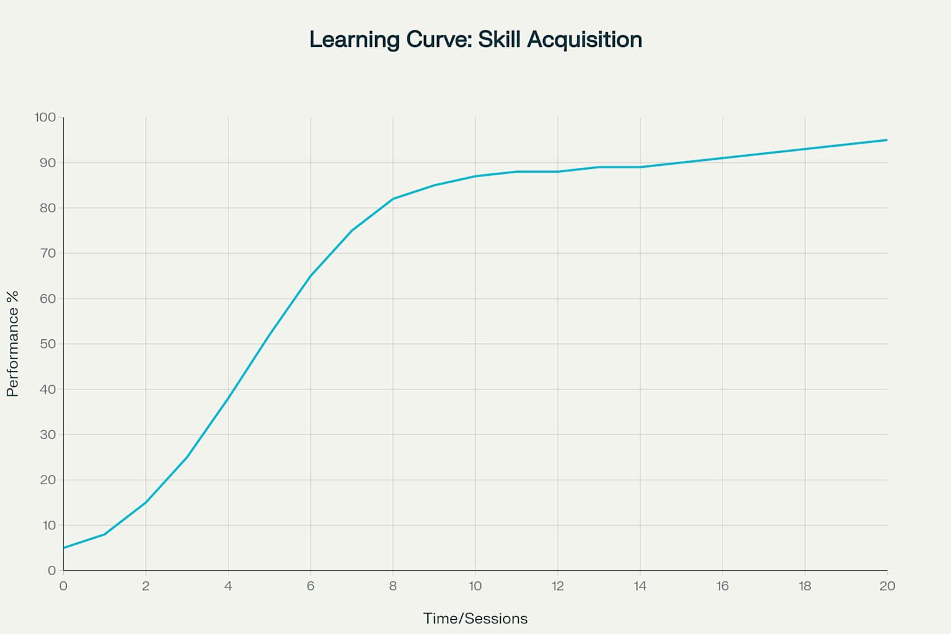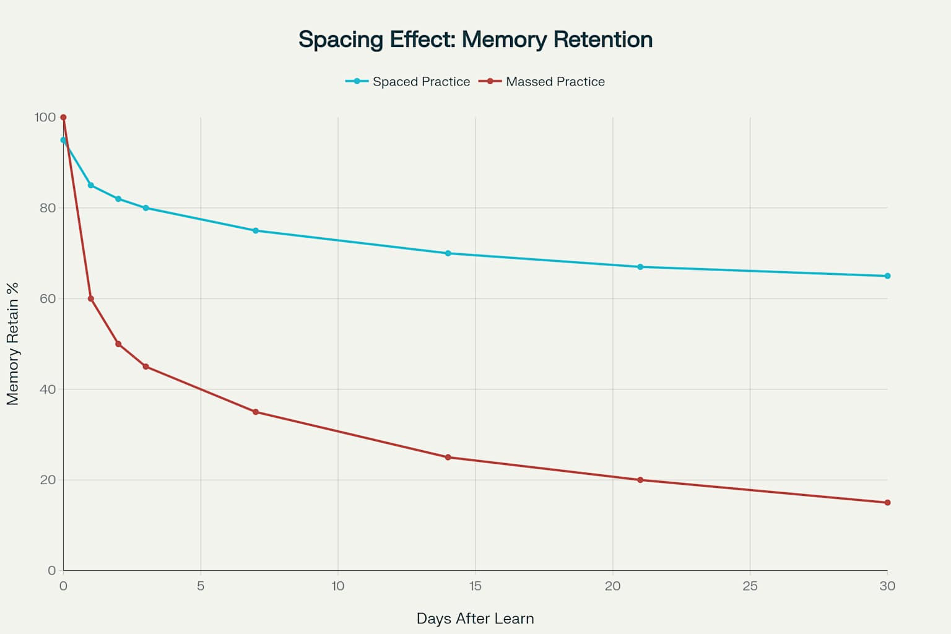Understanding how humans actually learn has never been more important. While we're surrounded by endless information and learning opportunities, the fundamental mechanisms of how our brains acquire, process, and retain knowledge remain remarkably consistent. These core principles from cognitive science can transform how we approach any learning challenge.
Cognitive Load: Your Mental Processing Power Has Limits
Think of your brain like a computer processor—it has limited working memory that can only handle so much at once [1][2][3]. When you're learning something new, you're using three types of mental effort: processing the essential difficulty of the material itself, dealing with poor presentation or distractions, and building lasting understanding [1][2]. The key insight is that overloading this system kills learning, but optimizing it accelerates mastery [1][3].

Effective learning design minimizes mental waste—like confusing instructions or cluttered interfaces—while maximizing productive struggle with the core concepts [1][2]. This explains why some tutorials feel overwhelming while others guide you effortlessly toward competence [2][3].
The Learning Curve: Progress Isn't Linear
Every skill follows a predictable pattern of development [4][5][6]. You start unconsciously incompetent (not knowing what you don't know), become consciously incompetent (aware of your gaps), progress to consciously competent (able but effortful), and finally reach unconsciously competent (automatic mastery) [5][6].

The plateau phases aren't learning failures—they're consolidation periods where your brain is organizing new knowledge [4][5]. Understanding this curve helps you persist through apparent stagnation and recognize that sudden breakthroughs often follow extended practice [5][6].
Spacing Effect: Time Is Your Memory's Best Friend
Here's a counterintuitive truth: forgetting helps learning [7][8][9]. When you space out practice sessions rather than cramming, you force your brain to work harder to recall information, which strengthens memory pathways [7][8][10]. Each time you successfully retrieve slightly-faded memories, you're essentially upgrading them to more permanent storage [7][10].

This explains why intensive weekend workshops often fail to create lasting change, while regular short sessions build expertise [8][9]. Your brain needs time between encounters to consolidate learning into long-term memory [7][11].
Retrieval Practice: Testing Yourself Creates Learning
The act of trying to remember something—not just reviewing it—is what actually builds memory strength [12][10][13]. This is why flashcards work better than highlighting, and why explaining concepts aloud trumps re-reading notes [12][10]. Every time you force yourself to recall information, you're literally rewiring your brain to make that knowledge more accessible [10][13].
Testing isn't just assessment; it's a learning strategy [12][13]. Low-stakes self-quizzing throughout the learning process dramatically improves retention compared to passive review [12][10].
Prior Knowledge: Learning Builds on What You Already Know
Your brain doesn't store new information in isolation—it connects everything to existing knowledge networks called schemas [14][15][16]. When you encounter new concepts, your mind immediately searches for familiar patterns and relationships [17][14][15]. This is why learning accelerates when you can relate new material to things you already understand [17][16].
Activating relevant background knowledge before diving into new topics isn't just helpful—it's essential for meaningful learning [17][14]. Without these connections, new information often fails to stick [14][16].
Transfer of Learning: The Ultimate Goal
The test of real learning isn't whether you can repeat information, but whether you can apply it in new situations [18][19][20]. Transfer happens when you recognize underlying principles that work across different contexts [18][19]. This is why problem-solving practice should vary surface features while maintaining core concepts [19][20].
Near transfer (applying learning to similar situations) happens relatively easily, but far transfer (applying principles to very different domains) requires deliberate practice with varied examples [18][19][20]. This is learning's holy grail—knowledge that generalizes beyond its original context [18][19].
Working Memory vs. Long-Term Memory: Two Different Systems
Your conscious thinking happens in working memory, which can only hold about 4 chunks of information at a time [21][22][23]. But your long-term memory has virtually unlimited storage capacity [21][23]. The challenge is getting information from the limited, temporary workspace into permanent storage [21][22].
This is why you can follow a complex explanation in the moment but struggle to recreate it later—the information never made it from working memory into long-term storage [21][23]. Meaningful learning requires deliberate strategies to build these connections [22][23].
Elaborative Processing: Making Connections Strengthens Memory
Instead of just repeating information, effective learning involves elaborating—explaining how concepts relate to each other and to what you already know [24][25]. When you ask "why?" and "how does this connect?" you're building rich networks of associations that make recall easier [24][25].
This is why teaching someone else is such a powerful learning tool—it forces you to organize information, identify connections, and fill gaps in your understanding [24][13]. The act of explanation deepens comprehension [24][25].
Attention: The Gateway to Learning
Without focused attention, information never makes it into your learning system [26][27][28]. Your brain is constantly filtering massive amounts of sensory input, and only attended information gets processed for potential storage [26][28]. This makes attention management perhaps the most crucial learning skill [27][28].
Multitasking during learning is largely a myth—divided attention typically means reduced learning [26][27]. Creating distraction-free environments and developing sustained focus abilities directly impact learning effectiveness [26][28].
Social Learning: We Learn by Watching Others
Humans are inherently social learners [29][30][31]. We acquire complex behaviors by observing others, not just through direct instruction [29][30]. This process involves attention (noticing the behavior), retention (remembering it), reproduction (trying it yourself), and motivation (having reason to continue) [29][30].
Effective learning environments leverage this natural tendency through modeling, demonstrations, and peer interactions [29][31]. Seeing others struggle and succeed normalizes the learning process and provides strategic insights [30][31].
Desirable Difficulties: Easy Learning Doesn't Last
Counterintuitively, learning that feels effortless often doesn't stick [9][32][33]. Introducing appropriate challenges—desirable difficulties—forces deeper processing that leads to more durable learning [9][32]. This might involve spacing practice, mixing problem types, or requiring generation rather than recognition [9][33].
The key is calibrating difficulty appropriately—too easy and learning is shallow, too hard and learners give up [9][32]. The sweet spot creates productive struggle that enhances long-term retention and transfer [32][33].
Interleaving: Mixing Topics Improves Learning
Rather than studying one topic until mastery before moving to the next (blocking), interleaving involves mixing different types of problems or concepts during practice sessions [34][35]. This approach initially feels more difficult but leads to better discrimination between concepts and improved transfer [34][35].
Interleaving works because it forces you to constantly identify which strategy or approach applies to each problem, strengthening your ability to recognize when to use different skills [34][35]. This mirrors real-world application where problems don't come pre-sorted by type [35].
Growth Mindset: Beliefs About Learning Matter
Whether you believe abilities are fixed traits or developable through effort profoundly impacts learning outcomes [36][37]. Growth mindset—the belief that intelligence and skills can be developed—leads to greater resilience, effort, and ultimately achievement [36][37].
This isn't just positive thinking; it changes how you interpret setbacks and challenges [36][37]. With a growth mindset, failures become information about what to work on next rather than evidence of inadequacy [36][37].
Metacognition: Learning to Learn
Perhaps the most powerful learning skill is metacognition—awareness and understanding of your own learning processes [38][39]. This involves planning how to approach learning tasks, monitoring your understanding during learning, and evaluating your performance afterward [38][39].
Students who develop metacognitive skills become more effective learners across all domains because they can diagnose their own learning needs and adjust strategies accordingly [38][39]. Teaching these "learning how to learn" skills may be education's highest leverage intervention [38][39].
The science of learning reveals that effective learning isn't about working harder—it's about working smarter. These principles, discovered through decades of cognitive research, can transform any learning endeavor from a struggle against your brain's limitations into a partnership with its natural mechanisms.

